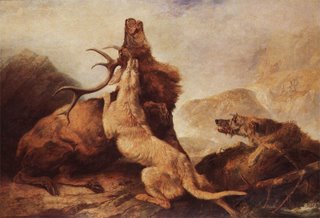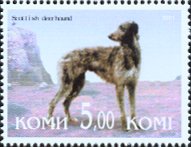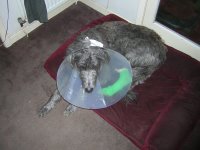
With the recent sightings of a white stag in Perthsire in the East Scottish Highlands, I thought as a deerhound I should investigate this ghost like of creatures further.
My instinct may be to set off in pursuit of the creature itself but the White Stag has several tales of Legend attached to it and woe to they who kill one as it is believed to bring all kinds of bad luck.
Read below a Celtic article culled from another website that I have reproduced as these articles are prone to disapearing into the ether as the deer disapear into the mist.
The White StagThe white stag is a familiar creature of myth and legend. Its origins are likely in the totemic period of early Indo-European society, particularly the northern societies of the Celts and pre-Indo-European cultures, whose subsistence was gained not only through agriculture, but through hunting.
1 This dependence on deer may be seen in the zoomorphic Celtic god Cernunnos, depicted as being a man with the antlers of a deer.
The white stag in Celtic myth is an indicator that the Otherworld is near. It appears when one is transgressing a taboo--such as when Pwyll tresspassed into Arawn's hunting grounds, or when Peredur entered the Castle of Wonders in his second adventure at the house of the Lame King. It also appears as an impetus to quest--the white stag or hart often appears in the forests around King Arthur's court, sending the knights off on to adventure against gods and fairies. (C. S. Lewis uses this device at both the beginning and end of The Lion, the Witch, and the Wardrobe.
2)
It also appears in French romance and lais as a similar indicator, such as in the lais of Marie de France, when Guigemar happens upon the strange sight of a white doe with antlers. He wounds the strange, hermaphroditic--note that word--animal, which curses him to grow up and fall in love.

It is also an important element of Hungarian mythology, which believed that a great white stag led the brothers Hunor and Magar to settle in Scythia. Thus were established the Huns and Magyars.
To Christians, the white stag came to symbolize Christ, perhaps in part inspired by the St. Eustace legend, wherein the Roman soldier Eustace is hunting, and happens upon a deer with a cross between his antlers. Eustace converts on the spot, and is put through numerous tragedies, persecutions, etc., including the death of his family, until being miraculously reunited with them. However, it is clear that this pious legend has pagan predecessors.
It is also worth noting that in Christian iconography, the unicorn is a symbol for Christ. There is a close identification between the white stag and the unicorn, and it can be reasoned that the white stag is the equivalent of the unicorn in these northern cultures, which do not record the existence of unicorns.
3The white hart also was the heraldic symbol of England's King Richard II.
The first thing to examine is the color: white is a symbol of purity, while also a symbol of otherworldliness. The white stag in Pwyll penduc Dyfed has a white body with red ears--the typical colors of otherworld creatures (the hounds of Arawn are also this color).
It is also associated with the sun; in Christian iconography, the stag appears with the sun between its horns. Earlier gods associated with the stag were also nature deities: Cernunnos, Fionn, Gwynn ap Nudd. Santa Claus--that half-memory of Odin/Thor--is drawn by eight reindeer--who may or may not be white.
The deer, finally, was a source of life, an important resource for early man.
Ultimately, the white stag is not only a creature of the gods, but is a god himself, symbolizing the creative life force of the universe--sex, life, and also death.
1. This split life between agriculture and hunting is readily seen in the Fenian Cycle of Irish literature--Fionn Mac Cumhill and his band, the Fianna, spend half the year in the forests, hunting, and the other half of the year in the service of the king. Fionn's original name was Demne, a word for dear, while his wife Sabd was transformed into a deer by a druid, and his son and grandson's names contain references to deer: Oisin "little deer," Oscar "deer-lover."
2. Oddly enough, the White Witch's sleigh is drawn by a white stag, and these are the first things Edmund sees when enterin Narnia, while it is a white stag which leads the children back to England. Perhaps this is an example of Lewis's occasional belief in relativism, that even the evil things of this world have some place in God's plan, though we can't see it. The white stag may be pulling the White Witch, but this is what draws Edmund, and then later the elder siblings, into Narnia. Otherwise, it is doubtful that everyone would have ever believed Lucy.
3. It is worth noting that the white stag in Peredur is described as having one horn--which is how it is described in the second continuation of Perceval. The Welsh version most likely originally described a white stag; the French turned that into the more familiar unicorn, and the later Welsh redactor of Peredur returned the animal to a stag, but keeping the odd image of a single horn.
Arthurian LegendBelow are reproductions from Arthurian Legend relating to the White Stag Hunt - these tales are drawn from different sources as credited and to accompany the text, included are book illustrations from 12th century scripts - notice the hounds of the hunt - Celtic hunting hounds perhaps? Hounds of the Gaels? these images are sourced from the
Bibliothèque nationale de FranceThe Hunt of the White Stag in Geraint, Son of Erbin

While Arthur is holding court at Caerlleon, the Forester of Dean (Madawc, son of Twrgardarn) arrives with news of the White Stag that will precipitate the adventure that is the story of Geraint (Erec) and Enid...
"In the Forest I saw a stag, the like of which beheld I never yet." "What is there about him," asked Arthur, "that thou never didst see his like?" "He is of pure white, Lord, and he does not herd with any other animal through stateliness and pride, so royal is his bearing." "It seems best to me," said Arthur, "to go and hunt him to-morrow at break of day; and to cause general notice there-of to be given tonight in all quarters of the Court." And Arryfuerys was Arthur's chief huntsman, and Arelivri was his chief page...
Now, this is how Arthur hunted the stag. The men and the dogs were divided into hunting parties, and the dogs were let loose upon the stag. And the last dog that was let loose was the favorite dog of Arthur. Cavall was his name. And he left all the other dogs behind him, and turned the stag. And at the second turn, the stag came towards the hunting party of Arthur. And Arthur set upon him. And before he could be slain by any other, Arthur cut off his head. Then they sounded the death horn for slaying, and they all gathered round...
Then they all set forth, holding converse together concerning the head of the stag, to whom it should be given. One wished that it should be given to the lady best loved by him, and another to the lady whom he loved best. And all they of the household, and the knights, disputed sharply concerning the head.
The Mabinogion, Geraint Son of Erbin Lady Charlotte Guest, trans. (London : J. M. Dent & Sons, 1910): pp220-21,231.The hunt of the White Stag in Chretien de Troyes' Erec and Enide...

On Easter day, in springtime,
at Cardigan, his castle,
King Arthur held court.
So rich a one was ever seen,
for there were many good knights,
brave and combative and fierce,
and rich ladies and maidens,
daughters of kings, noble and beautiful;
but before the court concluded
the king said to his knights
that he wanted to hunt the white stag
in order to revive the tradition.
My lord Gawain was not a bit pleased
when he heard this:
"Sire," said he, "from this hunt
you will never have either gratitude nor thanks.
We have all known for a long time
what tradition is attached to the white stag:
he who can kill the white stag
by right must kiss
the most beautiful of the maidens of your court,
whatever may happen.
Great evil can come from this,
for there are easily five hundred
Damsels of high lineage here,
daughters of kings, noble and prudent,
and there is not a one that is not the favorite
of some valiant and bold knight,
each of whom would want to contend,
either rightly or wrongly,
that the one who pleases him
is the most beautiful and the most noble."
The king replied: "This I know well,
but I will not give up my plan for all that,
for the word of a king
must not be opposed.
Tomorrow morning with great pleasure
we will all go to hunt the white stag
in the forest of adventures:
this hunt will be truly wondrous."
Thus was the hunt arranged
for the morrow, at daybreak.
The next day, as soon as it was light,
the king arose and made ready;
to go into the forest
he put on a short tunic.
He had the knights awakened,
the hunting-steeds readied.
They had their bows and their arrows,
and set off to hunt in the forest.
The queen mounted up after them,
accompanied by an attendant;
she was a maiden, daughter of a king,
and sat upon a good palfrey.
A knight came spurring after them:
his name was Erec.
. . . . . . . . . . . .
They rode speedily on
and came straight to the forest.
Those who had gone on ahead
Had already raised the stag:
some blew on horns, others shouted;
the dogs went noisily after the stag,
running, rushing and barking;
the archers were shooting thick and fast.
Out in front of all of them the king was hunting,
mounted on a Spanish hunter.
As the hunting party moves on ahead, Erec and the Queen chance upon a "armored knight on a charger," accompanied by a "fine looking maiden," and a dwarf, "who was very evil and baseborn." The confrontation is an ugly one; "Folly is not prowess; / in this Erec acted very wisely: / he withdrew...", but after reflection resolves to follow the knight and avenge himself.
Erec left the queen
and followed the knight.
And the queen remained in the woods,
where the king had caught up with the stag:
at the taking of the stag
the king arrived before any of the others.
They killed and took the white stag.
All started back,
carrying the stag as they went;
they arrived at cardigan.
After the evening meal, when the nobles
were joyful throughout the house,
the king, according to the tradition,
since he had taken the stag,
said that he would bestow the kiss
in order to observe the tradition of the stag.
Throughout the court there was much muttering:
They promised and swore to one another
that this would never be done without contention
by means of sword or lance of ash-wood.
Each one wanted, by deeds of arms,
to contend that his lady
was the most beautiful in the hall;
these words did not bode well;
When my lord Gawain heard this,
You may be sure that he was not at all pleased.
Chretien, de Troyes. Erec and Enide. Carleton W. Carroll, trans, ed. Garland Library of Medieval Literature; vol. 25. series A. (New York : Garland Publishing, 1987). pp 3-5,7,15.
Bad LuckAs an end to this article and an interesting footnote - The Archduke Franz Ferdinand shot and killed a white stag in his hunt - not long after this he himself was assainated - his death eventually (although not the only reason for) leading to the outbreak of the First World War - perhaps a stark warning to all deerhounds and their human associates who fancy bringing down the white deer - let it live to avoid the wrath of the gods!
Labels: Deerhound hunts white stag
 St Andrews Day
St Andrews Day The image features archaelogical remains. The Pictish sarcophagus was found by workmen in the grounds of St Andrews Cathedral in the 19th century. It is nearly 6 feet long and has elaborate carvings on the four sides and corner posts. It is believed to be a royal tomb shrine of a Pictish king and is one of the finest examples of Pictish carving in existence. The early Celtic 'Culdee' missionary monks built a church on the headland over looking St Andrews harbour ca. 800. It was replaced by the church of St-Mary-on-the-Crag, the outline of which is still visible outwith the cathedral grounds.
The image features archaelogical remains. The Pictish sarcophagus was found by workmen in the grounds of St Andrews Cathedral in the 19th century. It is nearly 6 feet long and has elaborate carvings on the four sides and corner posts. It is believed to be a royal tomb shrine of a Pictish king and is one of the finest examples of Pictish carving in existence. The early Celtic 'Culdee' missionary monks built a church on the headland over looking St Andrews harbour ca. 800. It was replaced by the church of St-Mary-on-the-Crag, the outline of which is still visible outwith the cathedral grounds. 

























